Introduction
Communication is a process of conveying information from one source to the other. Information rules the world, so there is a need for communication. Conveying information from one person to another is not a problem when the two parties are in close proximity, this implies that one man to one man communication is not a problem when the distance between them is short, the two parties can just interact directly, hence achieving communication. However, communication becomes more complex when a party(maybe one man or group of people) is addressing or conveying information to crowd, large audience or group of people and even more complex when one party is trying to convey information to people in far places, maybe in an entirely different geographical location. No matter how an information bearer shouts, someone in a very far distance cannot hear him form some reasons: human natural voice lack such power and wave attenuation; the further waves goes the likelihood of the wave dying out. it is not unfamiliar that human voice produces wave
So, to convey information from one location to another or even addressing multitude in same location, we require a system which is called communication system
The Communication System Fundamentals
Communication system is a group of components(subsystems) which enhances the conveying of information from one location to the other. Base on type of systems, a communication system is man made system in the sense that it was created through the knowledge of humans(i.e not natural) also communication system is a physical system in the sense that it can be seen. Using a public address system as example, you can see the microphone, the receivers and the speakers. Although the signal cannot be seen with the natural eye, but that does not disqualify the communication system form being a physical systemJust like any other system, the communication system has subsystem. Subsystems interact and the output of a subsystem becomes the input of another subsystem.
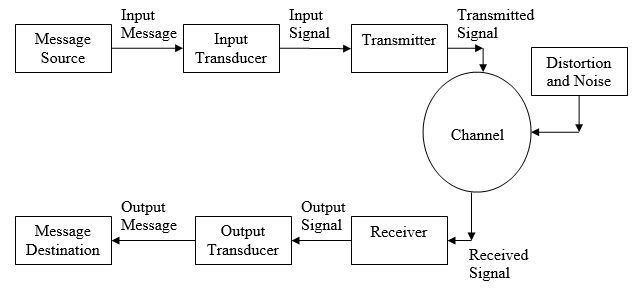
source: wikimedia License: Public domain
The different subsystems are designed to achieve a predetermined function or operation. For a better understating of the communication systems, it is imperative to understand the subsystems of the communication system which I will explain further in this series.
Transducer
Transducer is a subsystem of a communication system responsible for converting the signals into the corresponding voltage or current. Taking microphone as an example, when someone talks on microphone, the transducer on the microphone converts the voice signal into an equivalent electrical signal with some noise.Transmitter
Transmitter is a subsystem of any communication system responsible for matching/modulation the nature of the signal being transmitted to suite the channel/medium in which it is transmitted throughChannel or Medium
A channel or medium in a communication system is the path through which signals is transmitted through. Medium can be guided or unguided. Guided medium makes use of a physical path like coaxial cables, fiber optics, wave guides and so on, while unguided medium uses air as its pathReceiver
Before a signal is transmitted, it is first modulated. In other to recover the information in the modulated signal, there is a need for demodulation. Hence comes the role of a receiver, a receiver simply demodulates or decodes the information signal.Transmission Through A Guided Medium
In transmission through guided medium, there exist a physical conductor which is visible. The conductor can be a fiber optic cable, wave guide(which is a hollow conductor), coaxial cable (which is the most commonly used) and twisted pairs of cable. Transmitting through any of the conductor has its own benefit and disadvantage. On the average, transmitting through a guided medium is less costly to achieve and the complexity of the design is less.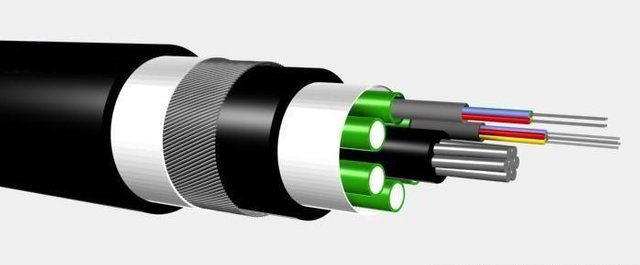
source: wikimedia Licensecreative commons
Also electromagnetic interference does not occur in guided transmission and noise is less.
However, a major advantages of guided medium transmission is distance and inconvenience. Imagine a teacher teaching with a coaxial cabled(wired) microphone and also walking around the circumference of the class, the wire might tangle with the seats in the class room which is inconvenience. Also imaging using wired microphone in a building of over 1 million capacity. This will require such a very long cables which would likely reduces aesthetic of the environment. Also twisting of the cable might lead to an internal cut, hence discontinuity in the cable.
Transmission Through An Unguided Medium
An unguided medium means no physical/visible conductor unlike in guided medium, simply we can say that air is the medium. However, depending on the distance in which we desire to transmit to and the frequency of transmission, different methods can be used to achieve unguided medium transmission which are:** the earths ionosphere, towers and satellite**. All that is needed for transmission to occur is a medium that can propagate the signal, a medium to reflect the propagated signals and a medium to receive the reflected wave signalsEarth's Ionosphere as an Unguided Medium
To understand ionosphere and its usage as unguided medium, it is crucial to have an understanding of what ions means. Ions are charge particles which can be either negatively charge (known as cation) or positively charged(known as anion). Sphere is a shape with approximate geometry similar to that of a circle. So literally, ionosphere meas a volume(geometrical shape) filled with ions, hence, ionosphere is a shell of electrons and electrically charged atoms and molecules that surrounds the EarthGeography studies has it that the shape of the earth is sphere and the earth posses different charge density at different geographical locations
The question now becomes, how does the earth's ionosphere severs as an unguided transmission medium. This process is very interesting
Prior to now, it is known that signals are either transmitted in form of voltage of current; and for a successful unbounded transmission, the electromagnetic wave signal propagated from the transmitter must be arrive at a nearby corresponding receiver. Literally, the wave from the transmitter foolows the ground waves to the receive.
A perfect example of transmission using the ground as medium is seen in the wireless microphone, when voice signal is feed into the microphone, the voice signal which is converted to a waveform(current or voltage signal) by an appropriate transducer is incident on the ground and then reflected to its nearby receiver. This receiver is connected to an amplifier and the amplifier to some speakers. This whole process makes the low voice signal loud.
Transmission using the ground has its own advantage in the sense that it is relatively cheaper compared to other unguided transmission medium, the ions on the ground is in abundance and readily available to use. However, it has a major disadvantage which is the distance between the transmitter and the receiver. The transmitter and receiver must be in a close proximity. The cause of this disadvantage can be easily explained using a simple scenario:
If you bring a mirror and allow the rays from the sun incident on it, the reflected rays can be seen on a nearby object, but if you take the same object to a distance very far away form the mirror, you would not see the reflected rays.
Same thing applies using the ground as a transmission medium, when the receiver is so far from the transmitter, the wave signals on the ground would not successfully reach the receiver , this is the reason why the voice heard on the speaker of a sound system tends to crack when the microphone is moved further from the receiver than the maximum distance allowed before attenuation
Another limitation of the using the ground as a transmission medium is that it cannot be used for transmission of VHF (very high frequencies) and UHF(Ultra High Frequencies) signals due to skin effect which lead to attenuation of high frequency signals. Due to this limitation, engineers found another means of transmission through an unguided medium which is the use of towers.
Cellular Tower As An Unbounded Medium
Previously, I have explained that for a successful unguided transmission of signals, a medium which can reflect the propagated (incident)signal to the receiver need to be employed. The smart question is what is the cellular tower made of?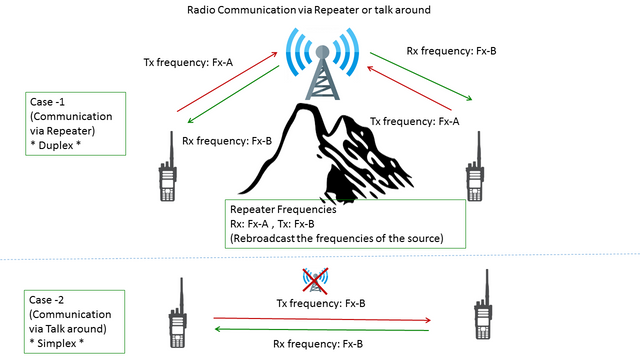
source: wikimedia Licensepublic domain
cellular towers are simply made of antennas, and in physics, it is a fact that an antennas is an electronic device which can transmit, receive and reflect EM waves according to its design. If it receives EM waves, it changes it to current or voltage; if the antenna is fed with voltage and current waveform, it changes it top EM waves; also it can serve as a reflector between an antenna to the another. All these depends on its design, some antennas can perform all these functions while some can perform only one of the functions.
The antenna can reflect wave signals to another antenna provided the line of sight is in range. Line of sight means the range of distance in which antenna reflecting a wave and the other antenna receiving the reflected wave can see each other.
In order to increase the line of sight, the antennas is mounted on a tall tower; tower is just a structure used to give considerable height to the antenna. Provided any two antennas can see each other, they can communicate(reflect the incident EM waves to each other). Two antennas which are not in line of sight, can also communicate if another third tower between the two cell towers in in line of sight with the two towers. So the higher the number of cell towers installed, the more the total line of sight is increased. Due to many cell towers, someone in Abuja can call someone in Lokoja; if it is only two cell towers, communication would be difficult to achieve.
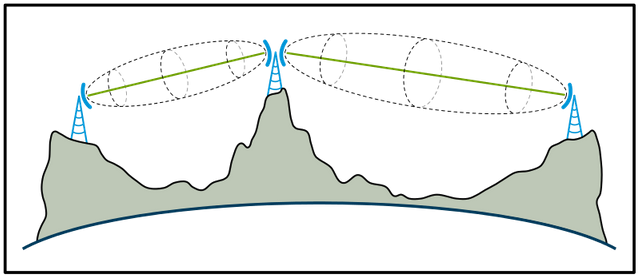
source:wikimedia License: Creative commons
Cellular towers are mainly used in telecommunication and broadcasting. A cellular tower designed for telecommunication is the reason you can make and receive calls with your phone; while a cellular tower designed for broadcast is the reason your electronic radio receiver could receive signals from radio based stations at real time. This is the reason cellular towers are seen in both radio broadcasting stations and network providers stations.
In other to use antennas as a medium, three categories of antennas must communicate: the first one is that of the transmitter(example mobile phone) emitting the EM waves, the second is the antenna to reflect the waves and the third is the antenna to receive the the reflected signals.
Using cell towers as an unguided transmission medium also has its own limitations. Due to the earths curvature, there are distances which two consecutive cell towers cannot see each other(that is the line of sight is out of range). Due to this limitation, another unguided medium of signal transmission comes to play which is Satellite.
Satellite As An Unguided Medium of Transmission
A satellite is a device designed to transmit and receive radio information signals . Satellite is the most sophisticated unguided medium of signal transmission. With satellite , communication is possible irrespective of distance or geographical location. Because the limitations of line of sight as applied to the cell tower is overcome.`
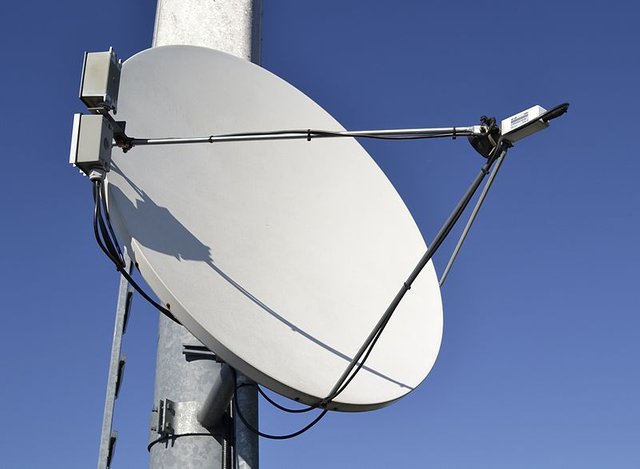
source:wikimedia License: Creative commons Description: receiving satelite dish installed in homes
The satellite is made of different antennas, and depending on design, some satellite can receive and transmit signals with the help of its transponder(a device which receives signals and emits signals)
For a complete communication using the satellite as an unguided medium, three categories of satellite are involved: the transmitting satellite(satellite dish) which is mounted in the broadcasting station base, the orbital satellite which will receive the transmitted wave and emit it, and finally the receiving satellite dish which is installed in various homes.
The above is the reason why to get a TV station like CNN, a satellite dish is installed considering latitude and longitude. CNN and other broadcasting stations already has their own satellite transmitting their signals to a corresponding orbital satellite, so to receive this signal, you need a satellite dish installed in your home. Similar things apply to other television channels.
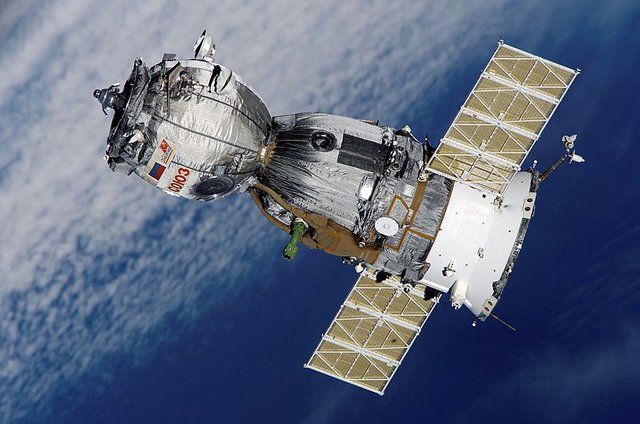
source:wikimedia License: Public Domain Description: orbital satellite
Conclusion
Communication is very essential from time immemorial upto this present, information is power, and communication is necessary so as to disseminate information. I have explained explicit in this article, the complexity involved in communication system when distance between transmitter and receiver is far away. Also transmission through a guided medium does not experience interference(which is a merit), but becomes a problem when distance is considered. This is overcome by using unguided medium of transmission. We have seen the limitations of propagating through an of the unguided medium be it the earth's ionosphere or a cellular tower. However, this whole limitations is overcome by using satellite.References
- The communication system fundamentals
- Guided medium transmission
- Unguided medium transmission
- Function of a cellular tower in a communication system
- Line of sight propagation
- Satellite Dish operation
- The function of a transponder
- Orbital satellite in communication system
- Ground waves transmission medium